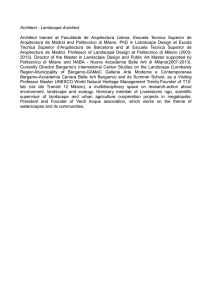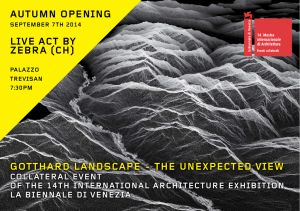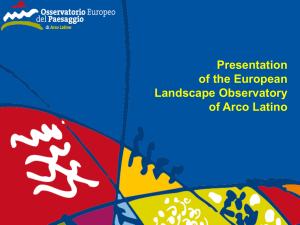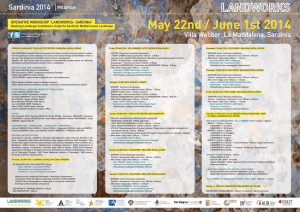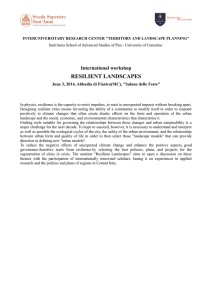Reading the landscape
advertisement
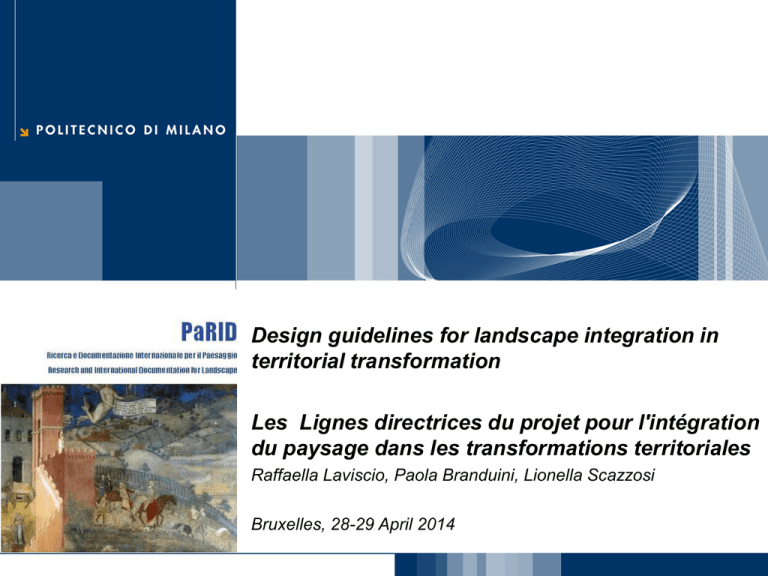
Design guidelines for landscape integration in territorial transformation Les Lignes directrices du projet pour l'intégration du paysage dans les transformations territoriales Raffaella Laviscio, Paola Branduini, Lionella Scazzosi Bruxelles, 28-29 April 2014 Introduction 2 Why the guidelines A helpful tool to diffuse best practises in landscape transformations They are beside the law Guidelines are usually more sensitive to environmental components there were a need of guidelines considering landscape as a palimpsest of traces and signs formal, symbolic and visual signs Paola Branduini, Raffaella Laviscio, Lionella Scazzosi Introduction 3 Scale National Local Inspired principles Codice dei Beni culturali e del Paesaggio (2004 and foll modif.) Cultural heritage and landscape code, Ministry of Cultural heritage DPCM 12 dicembre 2005 Landscape report Both are concerning protected landscapes Enlargement to any landscape due to European landscape convention ratified by Italian government in 2006 (11/01/ 06) Paola Branduini, Raffaella Laviscio, Lionella Scazzosi Objects 4 Rural buildings • Recovery, enlargement of existing rural buildings • New construction of agricultural buildings Technical equipment • Equipment with a strong technical component. In particular: 1. the energy system and its various production and transmission components, with particular reference to the renewable source energy production plants from (particularly wind and solar) 2. network and telecommunication systems (radio, television and telecommunications) Paola Branduini, Raffaella Laviscio, Lionella Scazzosi 5 Commitments MiBAC_Ministry of Cultural heritage and Tourism South Agricultural Park Milan Lombardy region Paola Branduini, Raffaella Laviscio, Lionella Scazzosi Foggia province Guidelines structure 6 The guidelines are divided in two sections: 1. “landscape knowledge”: it gives tools in order to read and value the landscape. 2. Suggestion of landscape project principles referring to the different categories of analyzed works The guidelines offer : a relevant iconographic resource an overview on bad and good projects realized in Italy and abroad. examples about the project research. They are the result of a network among expert people (academics, technicians, administrators, professional experts); They are based on the practice that helps to direct the suggestions (research by design). Paola Branduini, Raffaella Laviscio, Lionella Scazzosi Landscape knowledge 7 Proposed analysis: Defining of the study area and scale Law, protection tools and rules Survey Historical permanencies, remnants Landscape social perception (historical and lately) and meaning of the places (historical and lately) Landscape architecture We consider the landscape as a system, underlining the different relationships (functional, symbolic and sensorial) among the different elements. Guidelines give a lot of suggestions about sources, tools, information technology instruments and how to draw and communicate an issue. (In Italy one of the main problem is the lack of an effective communication of landscape characters) Landscape is not only the territory and it is not enough a functional description about the land use. Paola Branduini, Raffaella Laviscio, Lionella Scazzosi Reading the landscape Reading landscape architecture From «Linee guida per la valutazione paesaggistica degli impianti di produzione energetica da fonte rinnovabile nella provincia di Foggia», 2012 Paola Branduini, Raffaella Laviscio, Lionella Scazzosi 8 9 Reading the landscape Site architecture From «Gli impianti eolici : suggerimenti per la valutazione e la progettazione paesaggistica», 2006 Paola Branduini, Raffaella Laviscio, Lionella Scazzosi Reading the landscape 10 The landscape system Synchronical analysis 1722 From «Fabbricati rurali e paesaggio: suggerimenti per la valutazione e la progettazione paesaggistica», 2014 Paola Branduini, Raffaella Laviscio, Lionella Scazzosi Landscape design criteria 11 Design criteria are illustrated through (referring to the law): explanation of good and bad practices; comparison with international experiences; design simulation in different landscape situation/contest. A useful tool to verify the good quality of the design it is a check-list to prove/check: all the parameters to be taken into account in the analysis; the correct and essential documentation to deliver; a clear and more objective motivation of the project. Paola Branduini, Raffaella Laviscio, Lionella Scazzosi Interventions on existing buildings 12 Relationship with historical permanencies From «Fabbricati rurali e paesaggio: suggerimenti per la valutazione e la progettazione paesaggistica», 2014 Paola Branduini, Raffaella Laviscio, Lionella Scazzosi 13 New agricultural buildings Control of landscape relationship at different scale From «Fabbricati rurali e paesaggio: suggerimenti per la valutazione e la progettazione paesaggistica», 2014 Paola Branduini, Raffaella Laviscio, Lionella Scazzosi New agricultural buildings 14 In different morphological and historical contexts (Italian landscape variety) From «Fabbricati rurali e paesaggio: suggerimenti per la valutazione e la progettazione paesaggistica», 2014 Paola Branduini, Raffaella Laviscio, Lionella Scazzosi “Network and telecommunication systems guidelines – Local landscape territoral plan” 15 Way of setting telecomunication systems in a mountain and hill landscape High concentration of telecomunication systems on a historical building in a protected area Paola Branduini, Raffaella Laviscio, Lionella Scazzosi Masking attempts with the wrong use of the vegetation “Network and telecommunication systems guidelines – Local landscape territoral plan” 16 How to install energy pylons in a woodland How to install energy pylons in a large landscape How to install energy pylons in a splited landscape Paola Branduini, Raffaella Laviscio, Lionella Scazzosi “Network and telecommunication systems guidelines – Local landscape territoral plan” 17 Va evitata la costruzione di impianti in aree rurali (incluse le radure). In particolar modo perchè l’impatto risulta maggiore in quanto contrasta con l’aspettativa che l’osservatore ha di quel particolare luogo. Right collocation Al di fuori dei centri abitati gli impianti dovrebbero essere posizionati lungo le arterie di grande traffico, le linee ferroviarie e le linee elettriche già esistenti, per non creare ulteriori elementi di disturbo e di attraversamento del paesaggio. Wrong collocation I paesaggi industriali si presentano spesso destrutturati con immagini confuse. Gli edifici generalmente di grossa taglia e disposti su grandi superfici presentano un contesto in cui gli impianti possono trovare adeguata integrazione. Right collocation Alpeggio in alta Val Seriana Installazione di pannello fotovoltaico in posizione inadeguata rispetto all’ edificio. Nel caso di integrazione all’interno di edifici con caratteri costruttivi tradizionali, le installazioni dovrebbero essere posizionate sulle falde di copertura non visibili dalle visuali principali. Paola Branduini, Raffaella Laviscio, Lionella Scazzosi Wrong collocation “Wind farms: guidelines for the landscape project and evaluation MiBAC_Ministry of Cultural heritage and Tourism” 18 Wrong collocation in relation with historical buildings and due to different project scales Different impacts of a wind farm on a montain due to a different disposition of the machines Bad and good disposition related to the shape and the scale of landscape Paola Branduini, Raffaella Laviscio, Lionella Scazzosi 19 “Guidelines for the landscape project and evaluation of energy plants from renewable sources in the territory of Foggia Specific suggestions related to landscape characters and wind farms already made on the territory Paola Branduini, Raffaella Laviscio, Lionella Scazzosi Design mistakes in landscape reports New irregular windows “Dallas model” in Po Plaine (!) Paola Branduini, Raffaella Laviscio, Lionella Scazzosi 20 No identity of new horserecovery: bad adptation of existing building Mimesis: traditional material in industrial model 21 Dissemination and monitoring TOOLS INDICATORS Landscape commission: pool of expert (architect, agronomist, naturalist, ….) called to judge landscape compatibility of any landscape intervention (from small to large scale) in protected and non-protected site Direct participation in 3 landscape Commission at different territorial scale during the last 10 years Region (Great lakes commission) Province (PASM) Municipality (Rho e Olgiate Molgora) books, leaflet Rural building Wind farm technological equipments •awareness •clearness Web sites (of institutions) Ministry of Culture Region Lombardy Province of Milan •easy availability /traceability •easy way to downloading documents Meetings, conferences between technicians and researcher Themes of conferences Number of conferences organised by each institution Refresher course for professionals (mainly for architect, geometers…) Municipalities, Italia Nostra and other associations for landscape protection, professional associations “Compatibility of rural buildings” PASM Number of course organised by territorial organisation (municipality, park, province, region) Numbers and profession of participants Territorial plans with specific regards to landscape components Rules for historical centres Obligation to refer to local instructions Paola Branduini, Raffaella Laviscio, Lionella Scazzosi Verified trough professionals presenting landscape reports Results of Landscape Commission 22 It is potentially the most efficient way for dissemination of guide lines and raising awareness of the designers POSITIVE NEGATIVE Simplifying project evaluation by technicians Context partial evaluation Issued analysis: Photo survey of the closed context Project simulation of closed context Material and colour evaluation in the closed context Visual analysis in the closed context Better attention to the vegetal component Not issued analysis Photo survey of the large context • Historical analysis • Respect of the composition • New agricultural architecture quality • Social perception analysis Better purpose explanation of the project choices Project standardization (due to a trivial work of imitation) Paola Branduini, Raffaella Laviscio, Lionella Scazzosi Results of others tools 23 Book, leaf let Rural buildings: rich in examples and instructions but weak dissemination Technological equipment: book very diffused in particular among energy companies, on line magazines in the field of energy and of professional training Web sites RB_ Difficulty in findings guidelines in the web site of PASM TE_Frequent change of place in MiBAC website but often downloaded Meetings, RB_Frequent conferences concerning relationship between conferences city and countryside/urban agriculture or on respecting between environment/biodiversity (1 per year) ; less conferences on technicians and rural buildings Achieved a good landscape of closed context, weak reading of researcher TE_Greatreading attendance historical transformations and social perception Efficacycourse depends on good circumstances not(2009) only on; small tools of dissemination: Refresher RB_Organized only once attendance ; weak wind farm guidelines arrived at the right moment in the national debate for professionals dissemination TE_Attendance limited to potential evaluators than to the Courses were used seldom, not in a continuative way designers Paola Branduini, Raffaella Laviscio, Lionella Scazzosi Conclusion (how to work for a better situation?) 24 Catch technicians at the beginning of the project (design process) and not only during the project evaluation period through the introduction, for example, of landscape teaching at high school and universities trough participatory process between professionals (how? Time? Research by design, “territory game”…) Improve diffusion of guidelines To the «client»: not only among the experts or the professional but among the people as well; a landscape culture wide to the «client» is the first factor for an appropriate transformation that looks for more qualified technicians; activate specific courses for great public land owners; intercept or solicit sensitivity of public institutions Better integration with the territorial planning tools and laws through the introduction, for example, of incentives (as what happens in the field of environmental and energy spare design); Paola Branduini, Raffaella Laviscio, Lionella Scazzosi 25 Thank you for your attention! www.parid.polimi.it Paola Branduini, Raffaella Laviscio, Lionella Scazzosi
